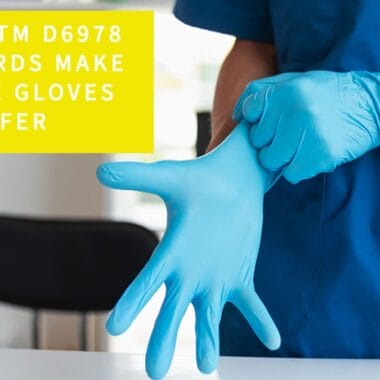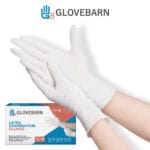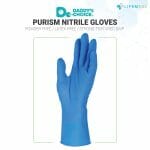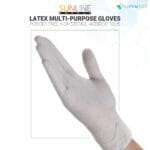Disposable gloves are a necessity in many industries and settings. They prevent individuals from exposure to dangerous substances and maintain a clean and orderly work environment. There are many different types of disposable gloves available on the market, each designed for a specific purpose or a multitude of purposes. In this blog post, we will discuss the different types of disposable gloves and their applications.
What Disposable Gloves are Used For
What makes disposable gloves ‘disposable’ is that they are single-use and meant to be thrown away after each use, in contrast to reusable gloves which can be used multiple times before they need to be cleaned or replaced.
Disposable gloves are great for:
- Preventing the spread of infection
- Protecting against hazardous materials
- Maintaining a clean and sterile work environment
- Avoiding contact with allergens
- Increasing grip
- Protecting hands from harsh chemicals
- Quickly and easily changing gloves
Different Types of Disposable Gloves
There are many different types of gloves available on the market, each designed for a specific purpose. Here are some of the most common types of gloves:
Latex Gloves
Latex gloves are made from natural rubber latex and provide a high level of barrier protection against viruses, bacteria, and other contaminants. Latex gloves are commonly used in the medical industry and are also frequently used in food service and other clean environments.
Pros: High level of barrier protection, good dexterity
Cons: Can cause allergies in some individuals
Nitrile Gloves
Nitrile gloves are made from synthetic rubber, making them an excellent barrier against viruses, bacteria, and other contaminants. Nitrile gloves are a good alternative for those with latex allergies and are commonly used in the medical industry and other clean environments.
Pros: Barrier protection that doesn’t impede dexterity
Cons: Can be more expensive than latex gloves
Vinyl Gloves
Vinyl gloves are made from PVC (polyvinyl chloride) and provide a good barrier against viruses, bacteria, and other contaminants. Vinyl gloves are a fantastic alternative for those with latex allergies and are commonly used in the food service industry and other clean environments.
Pros: Good barrier protection, latex-free
Cons: Not as puncture resistant as other gloves
Polyethylene Gloves
Polyethylene gloves are made from a variety of materials, including LDPE (low-density polyethylene), HDPE (high-density polyethylene), and LLDPE (linear low-density polyethylene). Polyethylene gloves are lightweight and provide a good barrier against viruses, bacteria, and other contaminants. Polyethylene gloves are commonly used in the food service industry and other clean environments.
Pros: Good barrier protection, lightweight
Cons: Less puncture-resistant than other types of disposable gloves
Choosing the Right Disposable Glove for the Job
When choosing the right glove for the job, it is important to consider the intended use of the glove. For example, latex gloves are a good choice for medical applications, while nitrile gloves are a better choice for food service or industrial applications. It is also important to consider the material of the glove, as some materials are better suited for certain applications than others. For example, vinyl gloves are a good choice for food service applications, while polyethylene gloves are a better choice for industrial applications.
Disposable Gloves in the Medical Field
In medical facilities, disposable gloves are worn by healthcare workers to prevent the spread of infection. Their gloves of choice are usually latex or nitrile gloves, as they provide the best barrier protection against bacteria and viruses. These gloves are great for short-term use and are typically disposed of after each patient interaction, but they can also be used for longer periods of time if necessary. Doctors and nurses often wear gloves when they are performing procedures or handling dressings and wounds.
Disposable Gloves in Food Service Establishments
Food service establishments also use disposable gloves to protect against the spread of infection and to maintain a clean and sanitary work environment. The glove of choice in this situation is typically vinyl, as it provides a good barrier against bacteria and other contaminants.
Disposable Gloves in Industrial Workplaces
Industrial workplaces also use disposable gloves to protect workers from a variety of hazards, including chemicals, cuts, and burns. These gloves are usually made from heavier-duty materials, such as nitrile or polyethylene, and are designed to withstand more wear and tear than gloves used in other applications.
Disposable Gloves in the Home
Disposable gloves can also be used in the home to protect against a variety of hazards, including cleaning chemicals, garden pesticides, and other household chemicals. They can also be used to protect your hands from dirt and grime when doing chores around the house.
Disposable Gloves in the Beauty Industry
When it comes to hair coloring, nail care, and waxing, gloves are ideal for protecting both the beautician and the client from a variety of hazards, including chemicals, dyes, and infection.
Disposable Gloves in Laboratories
In laboratories, disposable gloves are worn by scientists to protect themselves from a variety of hazards, including chemicals, infection, and radiation. These gloves are usually made from latex or nitrile, as they provide the best barrier protection. Scientists typically choose gloves that are comfortable and fit well, as they need to be able to work quickly and efficiently.
Disposable Gloves in the Automotive Industry
In the automotive industry, workers often wear gloves to protect their hands from a variety of hazards, including grease, oil, and chemicals. These gloves are usually made from nitrile or polyethylene, as they provide the best barrier protection.
Disposable Gloves in Construction
Construction workers also use disposable gloves to protect their hands from a variety of hazards, including dirt, dust, and chemicals. Gloves constructed of nitrile or polyethylene are the most effective at eliminating bodily contact.
There are many different applications for disposable gloves, and the type of glove you choose should be based on the specific needs of the task at hand. Whether you’re looking for protection from chemicals, infection, or radiation, there is a disposable glove that is right for you. Reach out to us today to learn more about the different types of disposable gloves and how they can be used to protect you in your work or home!



















Comments are closed.